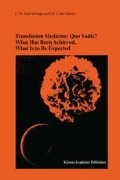Abstract
Following the discovery of hepatitis B virus (HBV) in 1970, immunoelectrophoretic method and subsequently, enzyme immunoassays (EIA) were developed and applied to the screening of the blood supply. Hepatitis B surface antigen (HBsAg) is currently screened world wide in blood donations. Post-transfusion hepatitis declined by approximately 75% following the implementation of the test. With time and the development of new technologies including monoclonal antibodies for HBsAg capture, microtitre plates or more efficient solid phase such as microparticles, the sensitivity of the test increased by 1000 fold to now reach 0.1ng/ml.
Access this chapter
Tax calculation will be finalised at checkout
Purchases are for personal use only
Preview
Unable to display preview. Download preview PDF.
References
Allain JP. The status of hepatitis C virus screening. Transfusion Medicine Reviews 1998;12:46–55.
Adarkwa M, Sarkodie F. Larbi RA, et al. HBsAg and anti-HIV pre-donation screening in volunteer and replacement blood donors in Kumasi. Ghana. 26th Congress of the International Society of Blood Transfusion, Vienna. 2000; abstract 352.
Schreiber GB, Busch MP, Kleinman SH, Korelitz JJ. The risk of transfusiontransmitted viral infections. N Engl J Med 1996:334:1685–90.
Sarkodie F. Adarkwa M, Bedu-Addo G, Opare-Sem O, Acheampong.I W, Allain JP. Screening for viral markers by EIA in volunteer and replacement donors in Kumasi, Ghana. 26th Congress of the International Society of Blood Transfusion, Vienna, 2000; abstract 351.
Lee H. Morse S, Olsvik O. Nucleic Acid Amplification Technologies: Application to Disease Diagnosis. Natick, MA: Eaton. 1997.
Muller-Breitkreutz K, Baylis SA, Allain JP. Nucleic acid amplification tests for the detection of blood-borne viruses. Vox Sang 1999;76:194–200.
Busch MP. Residual risks of viral transmission by transfusions and projected yields of additional screening tests. Trans Clin Biol 1996;3:7–11.
Murthy KK, Henrard DR, Eischberg JW, Busch MP, Alter H.I. Redefining the HIV infectious window in the chimpanzee model. Evidence to suggest that viral nucleic acid screening can prevent blood-borne transmission. Transfusion 1999:39:688–93.
Sugitani M, Inchauspe G, Shindo M, Prince A. Sensitivity of serological assays to identify blood donors with hepatitis C viraemia. Lancet 1992;339:1018–19.
Candotti D, Adu-Sarkodie Y. Davies F. et al. AIDS in an HIV-seronegative Ghanaian woman with intersubtype A/G recombinant II1V-I infection. J Med Virol 2000:62: I8.
lizuka H. Ohmura K, Ishijima A, et al. Correlation between anti-1313c titres and HBV DNA in blood units without detectable I IBsAg. Vox Sang 1992;63:107–11.
Allain JP, Hewitt PE, Tedder RS, Williamson LM. Evidence that anti-HBc but not HBV DNA testing may prevent some HBV transmission by transfusion. Brit J Haematol 1999;107:186–95.
Simon F, Mauclere P. Roques P. et al. Identification of a new human immunodeficiency virus type 1 distinct from the group M and O. Nat Med 1998: 4:1032–37.
Sakamoto Y. Yamada G. Mizuno M. et al. Full and empty particles of hepatitis 13 virus in hepatocytcs from patients with HbsAg-positive chronic active hepatitis. Lab Invest 1983;48:678–82.
Candotti C. Costagliola D. Joberty C. Bonduelle O. Rouzioux C. Autran B. the French ALT study group, Agut H. Status of long term asymptomatic HIV-I infection correlates with viral load but not with virus replication properties and cell tropism. J Med Virol 1999;58:256–64.
Ishii K. Rosa D. Watanabe Y, et al. High titers of antibodies inhibiting the binding of envelope to human cells correlate with natural resolution of chronic hepatitis C. H epatology 1998:28:1117–20.
Author information
Authors and Affiliations
Editor information
Editors and Affiliations
Rights and permissions
Copyright information
© 2001 Springer Science+Business Media Dordrecht
About this chapter
Cite this chapter
Allain, JP. (2001). Viral Marker Screening: Is More Testing Safer?. In: Sibinga, C.T.S., Cash, J.D. (eds) Transfusion Medicine: Quo Vadis? What Has Been Achieved, What Is to Be Expected. Developments in Hematology and Immunology, vol 36. Springer, Boston, MA. https://doi.org/10.1007/978-1-4615-1735-1_9
Download citation
DOI: https://doi.org/10.1007/978-1-4615-1735-1_9
Publisher Name: Springer, Boston, MA
Print ISBN: 978-1-4613-5700-1
Online ISBN: 978-1-4615-1735-1
eBook Packages: Springer Book Archive

